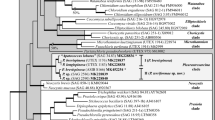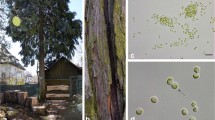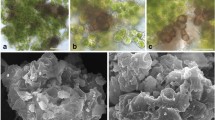Abstract
Strategies for life adaptation to extreme environments often lead to novel solutions. As an example of this assertion, here we describe the first species of the well-known genus of green unicellular alga Dunaliella able to thrive in a subaerial habitat. All previously reported members of this microalga are found in extremely saline aquatic environments. Strikingly, the new species was found on the walls of a cave located in the Atacama Desert (Chile). Moreover, on further inspection we noticed that it grows upon spiderwebs attached to the walls of the entrance-twilight transition zone of the cave. This peculiar growth habitat suggests that this Dunaliella species uses air moisture condensing on the spiderweb silk threads as a source of water for doing photosynthesis in the driest desert of the world. This process of adaptation recapitulates the transition that allowed land colonization by primitive plants and shows an unexpected way of expansion of the life habitability range by a microbial species.







Similar content being viewed by others
Abbreviations
- TEM:
-
Transmission electron microscopy
- SEM:
-
Scanning electron microscopy
- CLSM:
-
Confocal laser scanning microscopy
- a.s.l.:
-
Above sea level
References
Aasen AJ, Eimhjellen KE, Liaaen-Jensen S (1969) An extreme source of β-carotene. Acta Chem Scand 23:2544–2545
Akaike H (1974) A new look at the statistical model identification. IEEE Trans Autom Control 19:716–723
Azua-Bustos A, González-Silva C, Mancilla RA, Salas L, Palma RE, Wynne JJ, McKay CP, Vicuña R (2009) Ancient photosynthetic eukaryote biofilms in an Atacama Desert coastal cave. Microb Ecol 58:485–496
Ben-Amotz A (1980) Glycerol production in the alga Dunaliella. In: San Pietro A (ed) Biochemical and photosynthetic aspects of energy production. Academic Press, New York, pp 91–208
Ben-Amotz A, Avron M (1989) The biotechnology of mass culturing of Dunaliella for products of commercial interest. In: Cresswell RC, Ress TAV, Shah N (eds) Algal and cyanobacterial biotechnology. Longman Scientific and Technical Press, London, pp 90–114
Benoit JB, Lopez-Martinez G, Michaud MR, Elnitsky MA, Lee RE Jr, Denlinger DL (2007) Mechanisms to reduce dehydration stress in larvae of the Antarctic midge, Belgica antarctica. J Insect Physiol 53:656–667
Berden-Zrimec M, Drinovec L, Molinari I, Zrimec A, Umani SF, Monti M (2008) Delayed fluorescence as a measure of nutrient limitation in Dunaliella tertiolecta. J Photochem Photobiol B 92:13–18
Borowitzka LJ, Brown AD (1974) The salt relations of marine and halophilic species of the unicellular green alga, Dunaliella. The role of glycerol as a compatible solute. Arch Microbiol 96:37–52
Borowitzka MA, Silva CJ (2007) The taxonomy of the genus Dunaliella (Chlorophyta, Dunaliellales) with emphasis on the marine and halophilic species. J Appl Phycol 19:567–590
Borowitzka LJ, Borowitzka MA, Moulton TP (1984) The mass culture of Dunaliella for fine chemicals: from laboratory to pilot plant. Hydrobiologia 116(117):115–121
Brock TD (1975) Salinity and the ecology of Dunaliella from Great Salt Lake. J Gen Microbiol 89:285–292
Brown AD (1990) Microbial water stress physiology. Principles and Perspectives. Wiley, Chichister, pp 93–95
Brown AD, Borowitzka LJ (1979) Halotolerance of Dunaliella. In: Levandowsky M, Hutner SH (eds) Biochemistry and physiology of protozoa. Academic Press, New York, pp 139–190
Cáceres L, Delatorre J, Gómez-Silva B, Rodríguez V, McKay CP (2004) Atmospheric moisture collection from a continuous air flow through a refrigerated coil tube. Atmos Res 71:127–137
Cagle GD, Pfister RM, Vela GR (1972) Improved staining of extracellular polymer for electron microscopy: examination of Azotobacter, Zoogloea, Leuconostoc, and Bacillus. Appl Microbiol 24:477–487
Cereceda P, Osses P, Larraín H, Farias M, Schemenauer RS (2002) Advective, orographic and radiation fog in the Tarapacá region, Chile. Atmos Res 64:261–271
Cereceda P, Larrain H, Osses P, Farías M, Egaña I (2007) The climate of the coast and fog zone in the Tarapacá region, Atacama Desert, Chile. Atmos Res 64:301–311
Cereceda P, Larrain H, Osses P, Farías M, Egaña I (2008) Spatial and temporal variability of fog and its relation to fog oases in the Atacama Desert, Chile. Atmos Res 67:312–321
Chapman RL, Delwiche CF, McCourt RM (2002) Green algal conquest of the land: many conquests, one victory? J Phycol 38(S1): 3–3(1)
Chen H, Jiang JG (2009) Osmotic responses of Dunaliella to the changes of salinity. J Cell Physiol 219:251–258
Colomb A, Yassaa N, Williams J, Peeken I, Lochte K (2008) Screening volatile organic compounds (VOCs) emissions from five marine phytoplankton species by head space gas chromatography/mass spectrometry (HS-GC/MS). J Environ Monit 10:325–330
Delwiche CF, Karol KG, McCourt RM (2002) One small step: why did the charophytes have the right stuff? J Phycol 38(S1):6–6(1)
Demergasso C, Escudero L, Casamayor EO, Chong G, Balagué V, Pedrós-Alió C (2008) Novelty and spatio-temporal heterogeneity in the bacterial diversity of hypersaline Lake Tebenquiche (Salar de Atacama). Extremophiles 12:491–504
Espejo R (2001) Climatological and microbiological characteristics of the Camanchaca phenomenon at Cerro Moreno, Antofagasta, Chile. In: Proceedings of the second international conference on fog and fog collection, pp 463–466
Evangelista V, Evangelisti M, Barsanti L, Frassanito AM, Passarelli V, Gualtieri P (2007) A polychromator-based microspectrophotometer. Int J Biol Sci 3:251–256
Farías M, Cereceda P, Osses P, Nuñez R (2005) Spatial and temporal behavior of the stratocumulus cloud, fog producer in the coast of the Atacama desert (21° south lat., 70° west long.), during one month of winter and another of summer. Investig Geogr 56:43–61
Fassel TA, Edmiston CE Jr (1999) Ruthenium red and the bacterial glycocalyx. Biotech Histochem 74:194–212
Felsenstein J (1985) Confidence limits on phylogenies: an approach using the bootstrap. Evolution 39:783–791
Gómez PI, González MA (2004) Genetic variation among seven strains of Dunaliella salina (Chlorophyta) with industrial potential, based on RAPD banding patterns and on nuclear ITS rDNA sequences. Aquaculture 233:149–162
González MA, Gómez PI, Montoya R (1999) Comparison of PCR-RFLP analysis of the ITS region with morphological criteria of various strains of Dunaliella. J Appl Phycol 10:573–580
González MA, Coleman AW, Gómez PI, Montoya R (2001) Phylogenetic relationship among various strains of Dunaliella (Chlorophyceae) based on nuclear ITS rDNA sequences. J Phycol 37:604–611
González MA, Gómez PI, Polle JEW (2009) Taxonomy and phylogeny of the genus Dunaliella. In: Ben-Amotz A, Polle JEW, Subba Rao DV (eds) The alga Dunaliella, biodiversity, physiology, genomics and biotechnology. Science Publishers, Enfield, pp 15–44
Gouveia L, Oliveira AC (2009) Microalgae as a raw material for biofuels production. J Ind Microbiol Biotechnol 36:269–274
Hartley A, Chong G, Houston J, Mather A (2005) 150 million years of climatic stability: evidence from the Atacama Desert, northern Chile. J Geol Soc Lond 162:421–424
Hepperle D, Nozaki H, Hohenberger S, Huss VA, Morita E, Krienitz L (1998) Phylogenetic position of the Phacotaceae within the Chlamydophyceaeas revealed by analysis of 18S rDNA and rbcL sequences. J Mol Evol 47:420–430
Hosseini Tafreshi A, Shariati M (2009) Dunaliella biotechnology: methods and applications. J Appl Microbiol 107(1):14–35
Houston J, Hartley AJ (2003) The central Andean west-slope rainshadow and its potential contribution to the origin of hyper-aridity in the Atacama Desert. Int J Climatol 23:1453–1464
Kaçka A, Dönmez G (2008) Isolation of Dunaliella spp. from a hypersaline lake and their ability to accumulate glycerol. Bioresour Technol 99:8348–8352
Kaplan A, Reinhold L (1999) CO2 concentrating mechanisms in photosynthetic microorganisms. Annu Rev Plant Physiol Plant Mol Biol 50:539–570
Karol KG, McCourt RM, Cimino MT, Delwiche CF (2001) The closest living relatives of land plants. Science 294:2351–2353
Kraus R, Trimborn P, Ziegler H (2001) Delta13C and deltaD values of Opuntia atacamensis depending on different environmental conditions in the Atacama Desert of Northern Chile. Isot Environ Health Stud 37:161–165
Larrain H, Velásquez F, Cereceda P, Espejo R, Pinto R, Osses P, Schemenauer RS (2002) Fog measurements at the site ‘Falda Verde’ North of Chañaral (Chile) compared with other North Chilean fog stations. Atmos Res 64:273–284
Lewis LA (2002) Numerous transitions to land in green plants: the ‘other’ land plants. J Phycol 38(S1):22–22(1)
Liska AJ, Shevhenko A, Pick U, Katz A (2004) Enhanced photosynthesis and redox energy production contribute to salinity tolerance in Dunaliella as revealed by homology-based proteomics. Plant Physiol 136:2806–2817
Massyuk NP (1973) New taxa of the genus Dunaliella Teod. I. Ukr Bot Zh 30:175
McCourt RM, Delwiche CF, Karol KG (2004) Charophyte algae and land plant origins. Trends Ecol Evol 19:661–666
Mishra A, Jha B (2009) Isolation and characterization of extracellular polymeric substances from micro-algae Dunaliella salina under salt stress. Bioresour Technol 100:3382–3386
Nakada T, Misawa K, Nozaki H (2008) Molecular systematics of Volvocales (Chlorophyceae, Chlorophyta) based on exhaustive 18S rRNA phylogenetic analyses. Mol Phylogenet Evol 48:281–291
Olmos J, Paniagua J, Contreras R (2000) Molecular identification of Dunaliella sp. utilizing the 18S rDNA gene. Lett Appl Microbiol 30:80–84
Olmos-Soto J, Paniagua-Michel J, Contreras R (2002) Molecular identification of β-carotene hyper-producing strains of Dunaliella from saline environments using species specific oligonucleotides. Biotechnol Lett 24:365–369
Or D, Phutane S, Dechesne A (2007) Extracellular polymeric substances affecting pore-scale hydrologic conditions for bacterial activity in unsaturated soils. Vadose Zone J 6:298–305
Oren A (2005) A hundred years of Dunaliella research: 1905–2005. Saline Syst 1:2
Osaki S (1989) Thermal properties of spider’s thread. Acta Arachnologica 37:69–75
Osses P, Farías M, Nuñez R, Cereceda P, Larraín H (2005) Coastal fog, satellite imagery, and drinking water: student fieldwork in the Atacama Desert. Geocarto Int 20:69–74
Raja R, Hema-Iswarya S, Balasubramanyam D, Rengasamy R (2007) PCR identification of Dunaliella salina (Volvocales, Chlorophyta) and its growth characteristics. Microbiol Res 162:168–176
Rundel P, Dillon MO, Palma B, Mooney HA, Gulmon SL, Ehleringer JR (1990) The phytogeography and ecology of the coastal Atacama and Peruvian deserts. Aliso 13:1–50
Shaw E, Hill DR, Brittain N, Wright DJ, Täuber U, Marand H, Helm RF, Potts M (2003) Unusual water flux in the extracellular polysaccharide of the cyanobacterium Nostoc commune. Appl Environ Microbiol 69:5679–5684
Smith BM, Morrissey PJ, Guenther JE, Nemson JA, Harrison MA, Allen JF, Melis A (1990) Response of the photosynthetic apparatus in Dunaliella salina (green algae) to irradiance stress. Plant Physiol 93:1433–1440
Sterling C (1970) Crystal-structure of ruthenium red and stereochemistry of its pectic stain. Am J Bot 57:172–175
Swofford DL (2002) PAUP*: phylogenetic analyses using parsimony (*and other methods). Version 4.0b10. Sinauer Associates, Inc, Publishers, Sunderland
Teodoresco EC (1905) Organisation et développement du Dunaliella, nouveau genre de Volvocacée-Polyblepharidée. Beih z Bot Centralbl Bd. XVIII:215–232
Vehoff T, Glisovi A, Schollmeyer H, Zippelius A, Salditt T (2007) Mechanical properties of spider dragline silk: humidity, hysteresis, and relaxation. Biophys J 93:4425–4432
Vismara R, Verni F, Barsanti L, Evangelista V, Gualtieri P (2004) A short flagella mutant of Dunaliella sallina (Chlorophyta, Cholorophyceae). Micron 35:337–344
Acknowledgments
This work was supported by the Millennium Institute of Fundamental and Applied Biology (Chile). We also thank Alejandro Munizaga and Ximena Verges for technical support with microscopy and members of Rafael Vicuña’s Lab for critical comments and insights which helped to improve this manuscript.
Author information
Authors and Affiliations
Corresponding author
Additional information
Communicated by A. Oren.
Electronic supplementary material
Below is the link to the electronic supplementary material.
792_2010_322_MOESM1_ESM.tif
Figure S1.- Relative humidity (RH) profile inside the cave. A two week period is shown. The values were recorded every 10 minutes by an automatic RH microsensor placed between a spiderweb and the cave wall. (TIFF 151 kb)
792_2010_322_MOESM2_ESM.tif
Figure S2.- Confocal Laser Scanning Microscopy (CLSM) micrographs of the cave inhabiting subaerial Dunaliella. A) CLSM micrograph of aqueous suspension of Dunaliella atacamensis cells extracted from the spiderwebs, showing the pyrenoid (p). B) CLSM differential interference contrast (DIC) image merged with the red autofluorescence emitted by the chlorophyll of the cell chloroplast (c). (TIFF 865 kb)
792_2010_322_MOESM3_ESM.tif
Figure S3.- Absorption spectra of photosynthesis related pigments of the cave inhabiting Dunaliella. The inset shows a picture of chlorophyll a (left) and carotenoid (right) extraction. (TIFF 154 kb)
Supplemental Movie S1 of Dunaliella atacamensis colinized spiderwebs in situ. (AVI 4.61 MB)
Rights and permissions
About this article
Cite this article
Azúa-Bustos, A., González-Silva, C., Salas, L. et al. A novel subaerial Dunaliella species growing on cave spiderwebs in the Atacama Desert. Extremophiles 14, 443–452 (2010). https://doi.org/10.1007/s00792-010-0322-7
Received:
Accepted:
Published:
Issue Date:
DOI: https://doi.org/10.1007/s00792-010-0322-7




